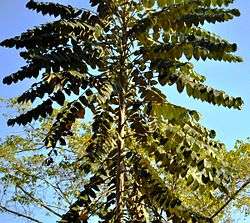mũtatĩ
Kikuyu

mũtatĩ (Polyscias fulva)
Pronunciation
- IPA(key): /mòtàtéꜜ/
Noun
mũtatĩ class 3 (plural mĩtatĩ)
- parasol tree
- Polyscias kikuyuensis;[1][3][4] produces soft timber, used traditionally for making beehive and mole-trap.[3][4]
- Polyscias fulva[2]
Related terms
(Nouns)
- gĩtatĩ class 7
References
- Beentje, H.J. (1994). Kenya Trees, Shrubs and Lianas. Nairobi, Kenya: National Museum of Kenya. →ISBN
- Maundu, Patrick and Bo Tengnäs (eds.) (2005). Useful Trees and Shrubs for Kenya, p. 354. Nairobi, Kenya: World Agroforestry Centre—Eastern and Central Africa Regional Programme (ICRAF-ECA). →ISBN Accessed online 20 August 2018 via http://www.worldagroforestry.org/usefultrees
- “mũtatĩ” in Benson, T.G. (1964). Kikuyu-English dictionary, p. 434. Oxford: Clarendon Press.
- Leakey, L. S. B. (1977). The Southern Kikuyu before 1903, v. III, p. 1303. London and New York: Academic Press. →ISBN
This article is issued from
Wiktionary.
The text is licensed under Creative
Commons - Attribution - Sharealike.
Additional terms may apply for the media files.